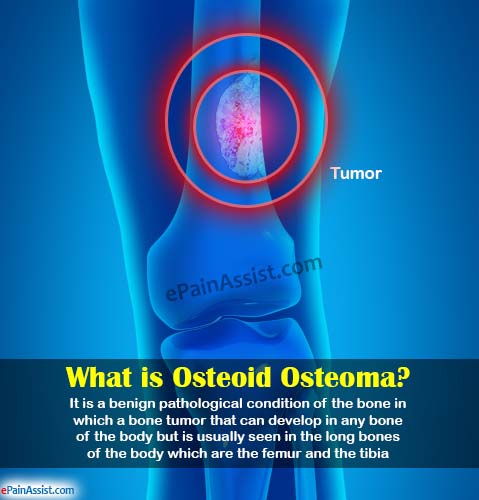What is Osteoid Osteoma?
Osteoid Osteoma is a benign pathological condition of the bone in which a bone tumor that can develop in any bone of the body but is usually seen in the long bones of the body which are the femur and the tibia. These tumors are not malignant and do not spread to other parts of the body but tend to cause a lot of pain and discomfort. Osteoid Osteomas are frequently found in children and adolescents but they can occur at any age. The size of an Osteoid Osteoma is approximately 1.5 cm. Once an Osteoid Osteoma is formed there is a large amount of reactive bone formed around them and also tend to form new bone material called the osteoid bone. This osteoid bone along with the tumor forms the center of the tumor and can be clearly seen on radiological imaging like x-rays.

What are the Symptoms of Osteoid Osteoma?
The classic presenting symptom of an Osteoid Osteoma is moderate pain in the affected extremity which gradually worsens over time, especially at night. Activity does not have any affect on the condition. Sometimes, an individual may be bearing with the pain for several years before an actual diagnosis is determined.
How is Osteoid Osteoma Diagnosed?
Normally, radiological studies in the form of x-rays of the affected area will clearly show the formation of an Osteoid Osteoma but before doing that the physician will take a history of the patient and conduct a physical examination. An x-ray of the affected extremity will clearly show the tumor. Sometimes a CT scan may also be done which may give more accurate picture and dimensions of the tumor. In order to rule out any malignant process going on a biopsy of the tumor will be done and if it comes out to be benign then a diagnosis of Osteoid Osteoma is confirmed.
How is Osteoid Osteoma Treated?
Osteoid Osteoma can be treated both conservatively as well as surgically:
Conservative Treatment for Osteoid Osteoma: It has been seen in many cases that with passage of time most of the Osteoid Osteomas go away on their own. For the symptoms of pain, the patient may be given NSAIDs for relieving pain and inflammation like ibuprofen or Tylenol.
Surgical Treatment for Osteoid Osteoma: In case if the tumor does not go away on its own then a surgical removal of the tumor is an option to consider. This is also an option for patients who have debilitating pain and want to get a definitive fix without waiting for years for the tumor to go away on its own. Curettage is the most preferred surgical procedure for Osteoid Osteoma. In this procedure, the entire tumor is scraped and scooped out. The surgeon will ensure that the entire tumor is removed or else it may have chances of growing back. In majority of the cases, this surgery has a high success rate, although just like any surgery it has its inherent risks of medical and anesthetic complications like bleeding, infection, damage to other structures and the like during the surgery.
Radiofrequency Ablation for Osteoid Osteoma: This is the latest advancement for treatment of Osteoid Osteoma. This type of procedure is minimally invasive and had a high success rate. It does not require the patient to be admitted for surgery and is an outpatient procedure. In this procedure, the tumor is destroyed by high frequency electric current. The electric current is passed into the tumor which heats up the tumor cells and effectively killing them without much damage to the surrounding tissues. This treatment has been shown to be quite successful for treating Osteoid Osteoma.
- Szendröi, Miklós. “Osteoid Osteoma: Diagnosis and Treatment.” The Journal of the American Academy of Orthopaedic Surgeons, Volume 8, Issue 6, 2000, pp 344-354. DOI: 10.5435/00124635-200011000-00005
- Mankin, Henry J., et al. “Osteoid Osteoma: Diagnosis, Localization, and Treatment.” Clinical Orthopaedics and Related Research, Volume 271, 1991, pp 197-200. DOI: 10.1097/00003086-199109000-00031
- Szendröi, Miklós. “Osteoid Osteoma: Diagnosis and Treatment.” The Journal of the American Academy of Orthopaedic Surgeons, Volume 8, Issue 6, 2000, pp 344-354. DOI: 10.5435/00124635-200011000-00005
- Demoor-Goldschmidt, Caroline, et al. “CT-Guided Percutaneous Radiofrequency Ablation of Osteoid Osteoma in Children.” Pediatric Radiology, Volume 44, Issue 6, 2014, pp 691-698. DOI: 10.1007/s00247-013-2847-6
- Stavas, Jason M., et al. “Osteoid Osteoma: Percutaneous Treatment with Radiofrequency Energy.” Radiology, Volume 223, Issue 1, 2002, pp 195-200. DOI: 10.1148/radiol.2231010890
